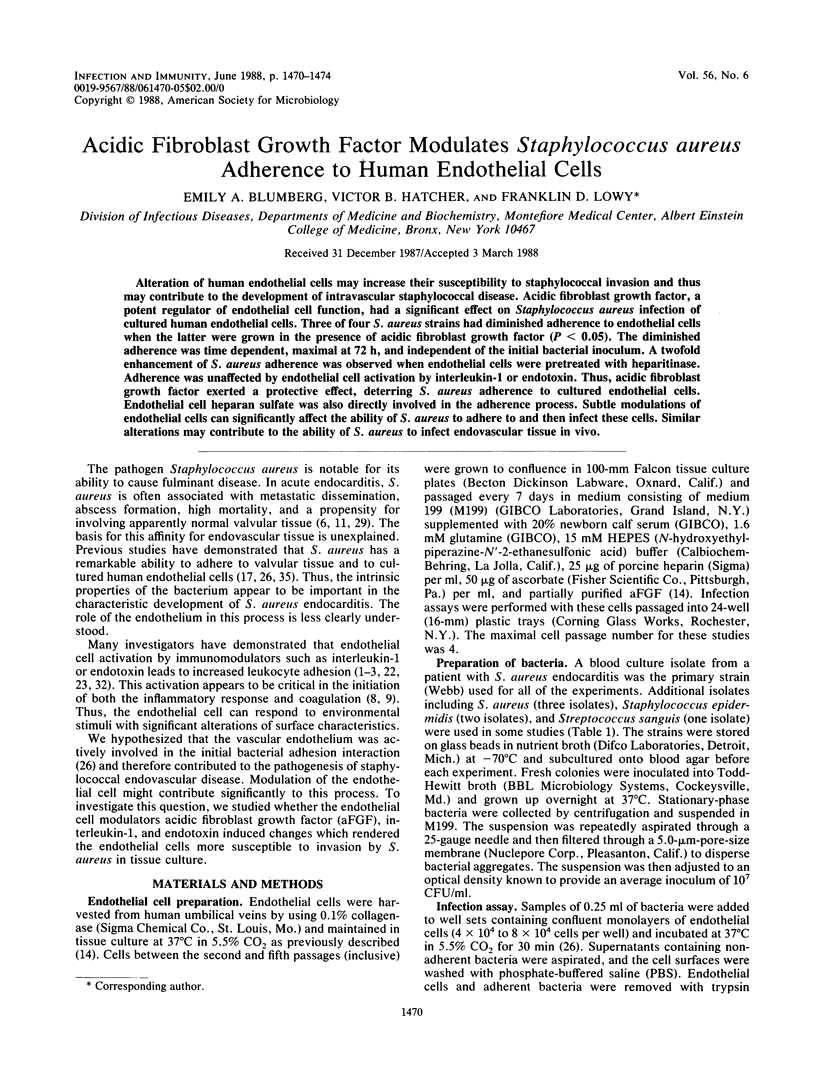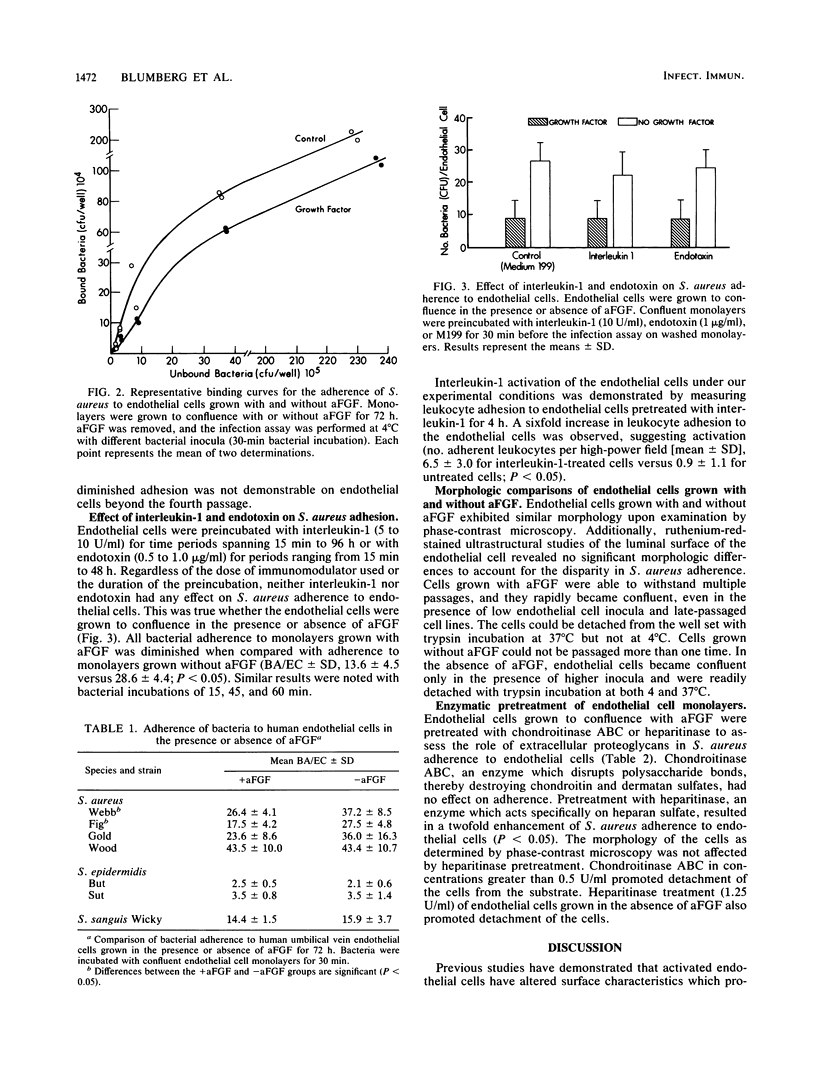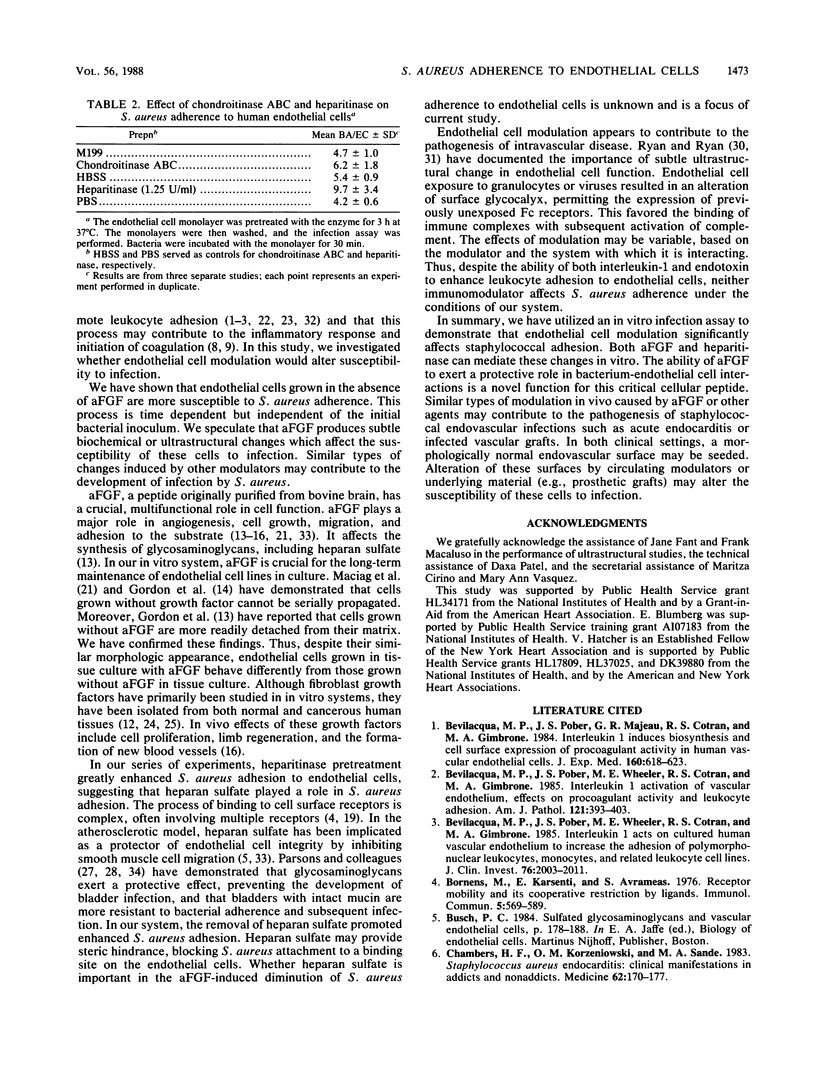Abstract
Alteration of human endothelial cells may increase their susceptibility to staphylococcal invasion and thus may contribute to the development of intravascular staphylococcal disease. Acidic fibroblast growth factor, a potent regulator of endothelial cell function, had a significant effect on Staphylococcus aureus infection of cultured human endothelial cells. Three of four S. aureus strains had diminished adherence to endothelial cells when the latter were grown in the presence of acidic fibroblast growth factor (P less than 0.05). The diminished adherence was time dependent, maximal at 72 h, and independent of the initial bacterial inoculum. A twofold enhancement of S. aureus adherence was observed when endothelial cells were pretreated with heparitinase. Adherence was unaffected by endothelial cell activation by interleukin-1 or endotoxin. Thus, acidic fibroblast growth factor exerted a protective effect, deterring S. aureus adherence to cultured endothelial cells. Endothelial cell heparan sulfate was also directly involved in the adherence process. Subtle modulations of endothelial cells can significantly affect the ability of S. aureus to adhere to and then infect these cells. Similar alterations may contribute to the ability of S. aureus to infect endovascular tissue in vivo.
Full text
PDF




Selected References
These references are in PubMed. This may not be the complete list of references from this article.
- Bevilacqua M. P., Pober J. S., Majeau G. R., Cotran R. S., Gimbrone M. A., Jr Interleukin 1 (IL-1) induces biosynthesis and cell surface expression of procoagulant activity in human vascular endothelial cells. J Exp Med. 1984 Aug 1;160(2):618–623. doi: 10.1084/jem.160.2.618. [DOI] [PMC free article] [PubMed] [Google Scholar]
- Bevilacqua M. P., Pober J. S., Wheeler M. E., Cotran R. S., Gimbrone M. A., Jr Interleukin 1 acts on cultured human vascular endothelium to increase the adhesion of polymorphonuclear leukocytes, monocytes, and related leukocyte cell lines. J Clin Invest. 1985 Nov;76(5):2003–2011. doi: 10.1172/JCI112200. [DOI] [PMC free article] [PubMed] [Google Scholar]
- Bevilacqua M. P., Pober J. S., Wheeler M. E., Cotran R. S., Gimbrone M. A., Jr Interleukin-1 activation of vascular endothelium. Effects on procoagulant activity and leukocyte adhesion. Am J Pathol. 1985 Dec;121(3):394–403. [PMC free article] [PubMed] [Google Scholar]
- Borens M., Karsenti E., Avrameas S. Receptor mobility and its cooperative restriction by ligands. Immunol Commun. 1976;5(6):569–589. doi: 10.3109/08820137609033867. [DOI] [PubMed] [Google Scholar]
- Chambers H. F., Korzeniowski O. M., Sande M. A. Staphylococcus aureus endocarditis: clinical manifestations in addicts and nonaddicts. Medicine (Baltimore) 1983 May;62(3):170–177. [PubMed] [Google Scholar]
- Conn G., Hatcher V. B. The isolation and purification of two anionic endothelial cell growth factors from human brain. Biochem Biophys Res Commun. 1984 Oct 15;124(1):262–268. doi: 10.1016/0006-291x(84)90946-x. [DOI] [PubMed] [Google Scholar]
- Dinarello C. A. Interleukin-1 and the pathogenesis of the acute-phase response. N Engl J Med. 1984 Nov 29;311(22):1413–1418. doi: 10.1056/NEJM198411293112205. [DOI] [PubMed] [Google Scholar]
- Dinarello C. A. Interleukin-1. Rev Infect Dis. 1984 Jan-Feb;6(1):51–95. doi: 10.1093/clinids/6.1.51. [DOI] [PubMed] [Google Scholar]
- Dreyer N. P., Fields B. N. Heroin-associated infective endocarditis. A report of 28 cases. Ann Intern Med. 1973 May;78(5):699–702. doi: 10.7326/0003-4819-78-5-699. [DOI] [PubMed] [Google Scholar]
- Folkman J., Klagsbrun M. Angiogenic factors. Science. 1987 Jan 23;235(4787):442–447. doi: 10.1126/science.2432664. [DOI] [PubMed] [Google Scholar]
- Gordon P. B., Conn G., Hatcher V. B. Glycosaminoglycan production in cultures of early and late passage human endothelial cells: the influence of an anionic endothelial cell growth factor and the extracellular matrix. J Cell Physiol. 1985 Dec;125(3):596–607. doi: 10.1002/jcp.1041250332. [DOI] [PubMed] [Google Scholar]
- Gordon P. B., Sussman I. I., Hatcher V. B. Long-term culture of human endothelial cells. In Vitro. 1983 Sep;19(9):661–671. doi: 10.1007/BF02628957. [DOI] [PubMed] [Google Scholar]
- Gospodarowicz D., Ferrara N., Schweigerer L., Neufeld G. Structural characterization and biological functions of fibroblast growth factor. Endocr Rev. 1987 May;8(2):95–114. doi: 10.1210/edrv-8-2-95. [DOI] [PubMed] [Google Scholar]
- Gospodarowicz D. Growth factors and their action in vivo and in vitro. J Pathol. 1983 Nov;141(3):201–233. doi: 10.1002/path.1711410304. [DOI] [PubMed] [Google Scholar]
- Gould K., Ramirez-Ronda C. H., Holmes R. K., Sanford J. P. Adherence of bacteria to heart valves in vitro. J Clin Invest. 1975 Dec;56(6):1364–1370. doi: 10.1172/JCI108216. [DOI] [PMC free article] [PubMed] [Google Scholar]
- Keusch G. T. Specific membrane receptors: pathogenetic and therapeutic implications in infectious diseases. Rev Infect Dis. 1979 May-Jun;1(3):517–529. doi: 10.1093/clinids/1.3.517. [DOI] [PubMed] [Google Scholar]
- Montesano R., Mossaz A., Ryser J. E., Orci L., Vassalli P. Leukocyte interleukins induce cultured endothelial cells to produce a highly organized, glycosaminoglycan-rich pericellular matrix. J Cell Biol. 1984 Nov;99(5):1706–1715. doi: 10.1083/jcb.99.5.1706. [DOI] [PMC free article] [PubMed] [Google Scholar]
- Montesano R., Orci L., Vassalli P. Human endothelial cell cultures: phenotypic modulation by leukocyte interleukins. J Cell Physiol. 1985 Mar;122(3):424–434. doi: 10.1002/jcp.1041220313. [DOI] [PubMed] [Google Scholar]
- Moscatelli D., Presta M., Joseph-Silverstein J., Rifkin D. B. Both normal and tumor cells produce basic fibroblast growth factor. J Cell Physiol. 1986 Nov;129(2):273–276. doi: 10.1002/jcp.1041290220. [DOI] [PubMed] [Google Scholar]
- Moscatelli D., Presta M., Rifkin D. B. Purification of a factor from human placenta that stimulates capillary endothelial cell protease production, DNA synthesis, and migration. Proc Natl Acad Sci U S A. 1986 Apr;83(7):2091–2095. doi: 10.1073/pnas.83.7.2091. [DOI] [PMC free article] [PubMed] [Google Scholar]
- Ogawa S. K., Yurberg E. R., Hatcher V. B., Levitt M. A., Lowy F. D. Bacterial adherence to human endothelial cells in vitro. Infect Immun. 1985 Oct;50(1):218–224. doi: 10.1128/iai.50.1.218-224.1985. [DOI] [PMC free article] [PubMed] [Google Scholar]
- Parsons C. L. Bladder surface glycosaminoglycan: efficient mechanism of environmental adaptation. Urology. 1986 Feb;27(2 Suppl):9–14. [PubMed] [Google Scholar]
- Parsons C. L. Prevention of urinary tract infection by the exogenous glycosaminoglycan sodium pentosanpolysulfate. J Urol. 1982 Jan;127(1):167–169. doi: 10.1016/s0022-5347(17)53654-x. [DOI] [PubMed] [Google Scholar]
- Reisberg B. E. Infective endocarditis in the narcotic addict. Prog Cardiovasc Dis. 1979 Nov-Dec;22(3):193–204. doi: 10.1016/0033-0620(79)90023-9. [DOI] [PubMed] [Google Scholar]
- Ryan U. S. Metabolic activity of pulmonary endothelium: modulations of structure and function. Annu Rev Physiol. 1986;48:263–277. doi: 10.1146/annurev.ph.48.030186.001403. [DOI] [PubMed] [Google Scholar]
- Ryan U. S., Ryan J. W. The ultrastructural basis of endothelial cell surface functions. Biorheology. 1984;21(1-2):155–170. doi: 10.3233/bir-1984-211-219. [DOI] [PubMed] [Google Scholar]
- Schleimer R. P., Rutledge B. K. Cultured human vascular endothelial cells acquire adhesiveness for neutrophils after stimulation with interleukin 1, endotoxin, and tumor-promoting phorbol diesters. J Immunol. 1986 Jan;136(2):649–654. [PubMed] [Google Scholar]
- Schwartz S. M., Gajdusek C. M. Growth factors and the vessel wall. Prog Hemost Thromb. 1982;6:85–112. [PubMed] [Google Scholar]
- Shrom S. H., Parsons C. L., Mulholland S. G. Role of urothelial surface mucoprotein in intrinsic bladder defense. Urology. 1977 May;9(5):526–533. doi: 10.1016/0090-4295(77)90245-x. [DOI] [PubMed] [Google Scholar]
- Vercellotti G. M., Lussenhop D., Peterson P. K., Furcht L. T., McCarthy J. B., Jacob H. S., Moldow C. F. Bacterial adherence to fibronectin and endothelial cells: a possible mechanism for bacterial tissue tropism. J Lab Clin Med. 1984 Jan;103(1):34–43. [PubMed] [Google Scholar]


